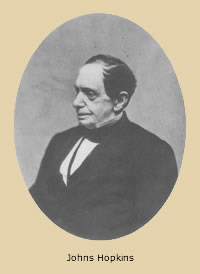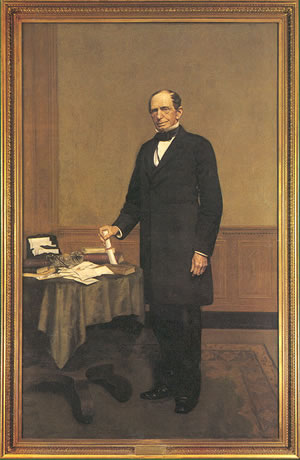| |
 The Last Will and Testament of Richard Snowden, the "Youngest", reveals that among many other bequests he gave 50 lbs. to his great-grandson, Samuel Hopkins, who later became the father of Johns Hopkins, the benefactor of the University, Hospital and Medical School that bear his name. The Last Will and Testament of Richard Snowden, the "Youngest", reveals that among many other bequests he gave 50 lbs. to his great-grandson, Samuel Hopkins, who later became the father of Johns Hopkins, the benefactor of the University, Hospital and Medical School that bear his name.
The family of Samuel and Hannah Hopkins, Snowden and Thomas descendants, lived at Whitehall, a tobacco plantation of 500 acres on the original Hopkins land grant located east of Route 301 near Millersville, Anne Arundel County, Maryland. As ardent Quakers, they lived simple, disciplined lives in accordance with the beliefs of the Society of Friends. As described by his niece, Samuel Hopkins was "an upright, noble-minded man, polite, considerate, entertaining in conversation, and much beloved by his friends and acquaintances." Hannah, devoted to literature and learning, memorized much of her favorite work, Homer's Iliad, and often spent time reading to her children. After her husband's death in 1814, she managed the family's finances so well that she accumulated $10,000, which she invested in son Johns' first business venture in Baltimore, a wholesale provisions house. From 1843 until her death in 1866 at the age of 91, Hannah lived in Johns' home at 18 West Saratoga Street in Baltimore.
Johns Hopkins became a wealthy businessman through several business partnerships and ultimately became the largest shareholder in the B&O Railroad. As a philanthropist in the early 1870s he gave 7 million dollars to establish, in Baltimore, a University dedicated to advanced learning, a Hospital that would give the best patient care, and a Medical School that would train highly competent physicians and further the advancement of medicine. The Johns Hopkins University opened in 1876, The Hospital in 1889, and the Medical School in 1893. The  Johns Hopkins Portrait, shown below, stands on the ground floor of the Johns Hopkins Hospital Rotunda, just inside the entrance on Broadway Street. Johns Hopkins Portrait, shown below, stands on the ground floor of the Johns Hopkins Hospital Rotunda, just inside the entrance on Broadway Street.
In 1989 there was a celebration of the 100th anniversary of the opening of the Hospital and the Postal Service immortalized Johns Hopkins on a US postage stamp. Present at this celebration were Dr. George A. Scheele and Edward and Mary Warfield. Dr. Scheele had graduated from the Johns Hopkins Medical School in 1965 and served two years of residency training in Internal Medicine on the prestigious William Osler Medical Service before embarking on a successful career in Academic Medicine at the Rockefeller University, the Yale University School of Medicine and Harvard Medical School. A summary of Dr. Scheele's career may be viewed at Dr. George Scheele's Website. Ed Warfield, an Episcopal minister, worked in the Human Resources Office at the Johns Hopkins University for many years. See an enlarged rendition of the Johns Hopkins postage stamp shown at this memorial celebration.
Returning to an earlier time, James Carey Thomas (Snowden descendant) was a medical doctor and best friend of Daniel Coit Gilman, the first President of the Johns Hopkins Hospital. It is generally recognized that it was Gilman's talent and vision which led to the selection of the four great doctors at the hospital (William Osler, William Welch, William Halsted, and William Kelley). Apparently, Dr. Thomas played an informal but critical role during this seminal period in the development of both the Hospital and Medical School. At Dr. Thomas' death Dr. Osler, the first Chairman of the department of Medicine at Hopkins, was said to have dismissed his class telling them that the man they were indebted to for the medical school had died. Dr. Welch, the first Professor and Chairman of the Department of Pathology at Hopkins, and Dr. Osler were pallbearers at the funeral and the Trustees and Professors marched together in a body to the Quaker Meeting House.
Martha Carey Thomas, the daughter of Dr. James Carey Thomas formed the "Group" that raised the necessary funds to open the Johns Hopkins Medical School in 1892. The sharp decline in B&O RR stock had seriously threatened the opening of the Medical School. The group of four women, all in their twenties, including Martha Carey Thomas and Mary Garrett, raised most of the $500,000 necessary to save the Medical School. Their gift was called the "Womens Memorial Fund" and was contingent on a change of School policy, which would allow admission of women on an equal basis with men. In 1892 this was a radical change in tradition.
Helen Whitall Thomas, Martha Carey's sister, married Simon Flexner, who worked for many years in the Department of Pathology at the Johns Hopkins Medical School under William Henry Welch and became the first Director of the Rockefeller Institute (now Rockefeller University) in New York City. Simon Flexner's brother, Abraham Flexner, developed the first accreditation system for medical schools in the United States, was involved in founding the Rockefeller Foundation and founded the institute for advanced Studies in Princeton, NJ.
Letter of Johns Hopkins to the Trustees
Benefactor and Founders of Johns Hopkins Hospital
The Johns Hopkins Postage Stamp (1989 Anniversary of the Opening of The Johns Hopkins Hospital)
Johns Hopkins Hospital, Opening Day 1889
|